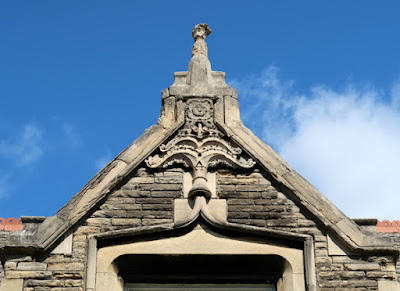 |
| Ancaster stone dressings on the boys' school |
After a very brief but productive exploration of Hillsborough, starting at the Hillsborough Board School and then proceeding to Hillsborough Hall and Hillsborough Barracks, I finished by going to have a look at the former Langsett Road Board School, which is located on Burton Street.
I had by now briefly surveyed the stonework of 20 Sheffield Board Schools, 10 of which had been designed by CJ Innocent of Innocent and Brown. All of the latter, up to the Manor Board School – built in 1876 – display his trademark details: recessed arches, trefoils, herringbone masonry, a datestone and the Sheffield Board Crest, as well as prominent bell towers and chimneys.
The Langsett Board School, however, shows no trace whatsoever of Innocent’s trademark Domestic Gothic architectural details, despite only being built three years later in 1879 and, if it wasn’t for the fact that the Victorian Society book Building Schools for Sheffield states that this was his work, I would have said that it had been designed by another architect.
Having got this distinct impression from a cursory inspection of the original school buildings fronting Burton Street, which is now the Burton Street Foundation, I took advantage of an open gate to have a quick look at the rear of the boys’ school.
The only feature shared in common with CJ Innocent’s earlier schools is the covered play area, which is now incorporated within the building. Very briefly looking at the extremely plain 1888 addition by Wightman and Wightman, the architects responsible for the latter additions to the Manor Board School, I came to the rear of the block that had been built for the infants and girls.
Looking at the stonework from a distance, I was curious to see that although the walling stone was dirty, which I have assumed to be Crawshaw Sandstone, the dressings contrasted quite strongly in colour – unlike the Stoke Hall stone and other medium grained gritstone that I had seen in other schools, where they had developed a patina that was similar in colour to the walling stone.
When photographing the carved datestone above the arch to the loggia, which shelters the main entrance to the girls’ block, I could see that it is not carved in sandstone but limestone, which has ripple marks characteristic of Ancaster stone from the Jurassic Lincolnshire Limestone.
At the time of my visit, an athletics event for teenagers was taking place, with plenty of people milling about, so I didn’t hang around to closely examine the other dressings but, standing at a distance, they appear to be very uniform in colour and are therefore presumably the same stone.
The building still retains its original boundary walls and inscribed gate piers, which are made of medium/coarse grained massive sandstone, but it was the use of limestone for dressings that was intriguing me - compounded by another use of it in the central gable of the boys’ school.
 |
| Ancaster stone used for the gable of the boys' school |








No comments:
Post a Comment